Zoomlion RT60 Service Manual

OPERATOR'S MANUAL FOR RT60 ROUGH TERRAIN CRANE
Address:Quantang Indust=rial Park, 2nd Yuanda Road, Changsha Economic and Technological Development Zone, Hunan Province, China
Postcode: 410131 Website: www.zoomlion.com

RT60 ROUGH TERRAIN CRANE
OPERATOR’S
MANUAL
Edition 1
Dec. 2013

Zoomlion Cranes appreciates your selection of the ZOOMLION Rough Terrain Crane for your application.
No one should operate the crane unless they read and understand the information in this manual.
When you follow the instructions in this manual, your crane can operate at MAXIMUM EFFICIENCY.
The operator must keep this manual in the cab of the crane.
If there is anything in the manual that you do not understand, speak with us. We (Zoomlion Cranes) are NOT responsible for damages from an operator who does not obey the instructions in the OPERATOR’S MANUAL.
The OPERATOR’S MANUAL is an important part of the crane. If the crane becomes the property of a different person, make sure that the manual stays in the cab of the crane.
THANK YOU!
Mobile Crane Branch Company of ZOOMLION Heavy Industry Science and Technology Co., Ltd.
Copyright
Under the copyright laws, this manual may not be copied, photocopied, reproduced, translated, or reduced to any electronic medium or machine readable form, in whole or part, without the prior written consent of Zoomlion Heavy Industry Science and Technology Co., Ltd.
Copyright © 20XX, Zoomlion Heavy Industry Science and Technology Co., Ltd. All rights reserved.
RT60 Rough Terrain Crane |
I |
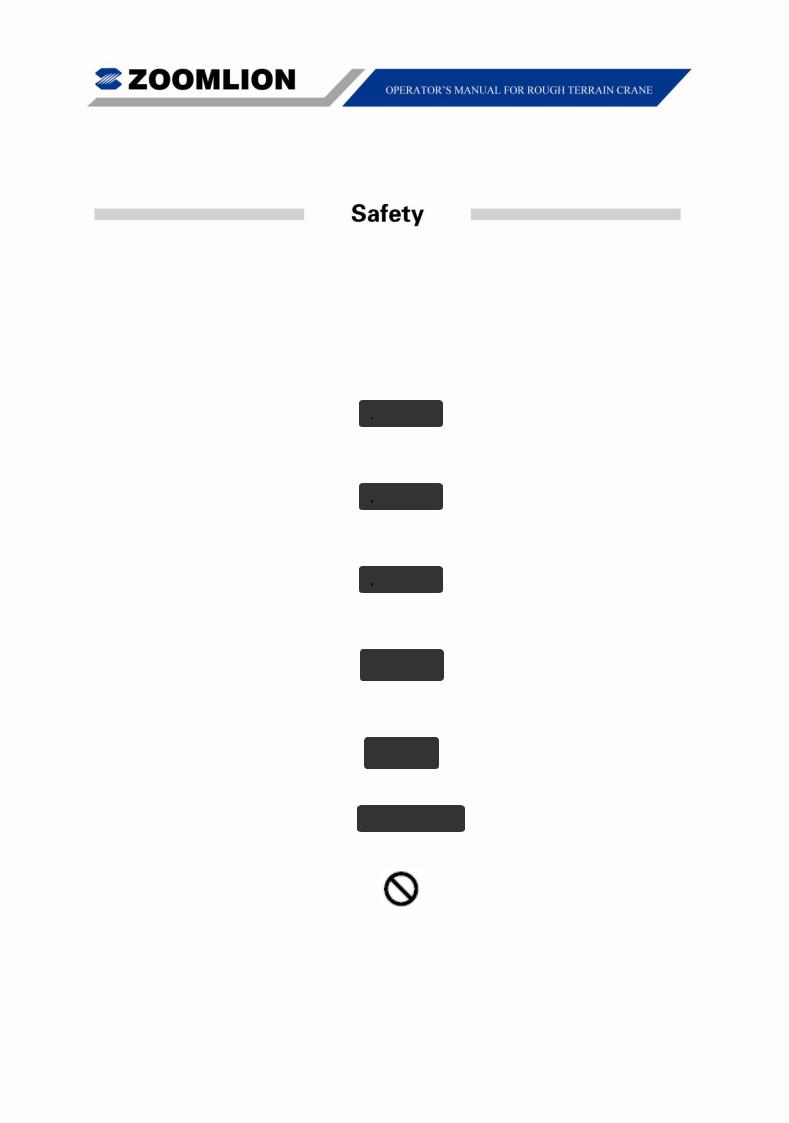
Hazard Indicators
DANGER, WARNING, CAUTION, ATTENTION, NOTE, and IMPORTANT labels are on signs and decals, and as you read this manual to show important instructions. In this manual, DANGER, WARNING, and CAUTION labels are before the paragraph or item to which they apply. ATTENTION, NOTE, and IMPORTANT follow the paragraph or item they apply to. The markers are as follows:
 Danger
Danger
Refers to a dangerous situation which, if you do not prevent, will cause death or injury.
 Warning
Warning
Refers to a possible dangerous situation which, if you do not prevent, could cause death or injury.
 Caution
Caution
Refers to a possible dangerous situation which, if you do not prevent, may cause light or moderate injury.
Attention
Refers to a situation which, if you do not prevent, may cause property or equipment damage.
Note
Refers to a tip or hint in the operation instructions.
 Important
Important
Emphasizes the importance of the data in this manual.
This symbol shows a step or procedure that is not approved and can cause a dangerous situation.
II |
RT60 Rough Terrain Crane |

To owners, users and operators............................................................................................... |
I |
||
Safety. ........................................................................................................................................ |
II |
||
1 |
Foreword......................................................................................................................... |
01-1 |
|
2 |
Nomenclature ................................................................................................................. |
02-1 |
|
3 |
Introduction .................................................................................................................... |
03-1 |
|
4 |
Safety .............................................................................................................................. |
04-1 |
|
5 Operating conditions and points for attention . .......................................................... |
05-1 |
||
5.1 |
|
Operating conditions ..................................................................................................... |
05-1 |
5.2 |
|
Pre-departure checks (to job-site) . ............................................................................... |
05-3 |
6 |
Controls and instruments. ............................................................................................ |
06-1 |
|
6.1 |
|
Upper controls and instruments . .................................................................................. |
06-1 |
|
|
6.1.1 Air conditioner control panel. ............................................................................ |
06-6 |
|
|
6.1.2 Media player...................................................................................................... |
06-9 |
6.2 |
|
Controls and instruments . .......................................................................................... |
06-10 |
6.3 |
|
Monitor ........................................................................................................................ |
06-15 |
6.4 |
|
Boom mode selection.................................................................................................. |
06-36 |
7 |
Operating instructions................................................................................................... |
07-1 |
|
7.1 |
|
Safety equipment .......................................................................................................... |
07-1 |
7.2 |
|
Starting the engine ........................................................................................................ |
07-2 |
7.3 |
|
Operating the engine..................................................................................................... |
07-2 |
7.4 |
|
Cold weather starting .................................................................................................... |
07-2 |
7.5 |
|
Starting off and parking operation. ................................................................................ |
07-3 |
7.6 |
|
Economical driving ........................................................................................................ |
07-4 |
7.7 |
|
Steering operation ......................................................................................................... |
07-5 |
7.8 |
|
Braking operation .......................................................................................................... |
07-6 |
7.9 |
|
Transmission operation ................................................................................................. |
07-7 |
7.10 |
Towing......................................................................................................................... |
07-8 |
|
7.11 |
PTO operation ............................................................................................................. |
07-8 |
|
7.12 |
Outrigger operation ................................................................................................... |
07-10 |
|
7.13 |
Hoist operation .......................................................................................................... |
07-13 |
|
7.14 Operation of main boom and its telescoping system. ............................................... |
07-23 |
||
7.15 |
Luffing operation ....................................................................................................... |
07-26 |
|
7.16 |
Swing operation ........................................................................................................ |
07-28 |
|
7.17 |
Simultaneous crane movements . ............................................................................. |
07-31 |
|
7.18 |
Jib operation.............................................................................................................. |
07-37 |
|
7.19 |
Rooster sheave ......................................................................................................... |
07-45 |
|
7.20 |
Vehicular operation ................................................................................................... |
07-47 |
|
RT60 Rough Terrain Crane |
III |

7.21 |
“On tires” lifts............................................................................................................. |
07-50 |
|
7.22 |
Unusual operating conditions. .................................................................................. |
07-51 |
|
8 |
Transportation and storage. ......................................................................................... |
08-1 |
|
8.1 |
|
Transportation ............................................................................................................... |
08-1 |
8.2 |
|
Storage.......................................................................................................................... |
08-3 |
9 |
Specifications................................................................................................................. |
09-1 |
|
9.1 |
|
Conversion tables ......................................................................................................... |
09-1 |
9.2 |
|
Average weight of materials. ........................................................................................ |
09-3 |
9.3 |
|
Torque ratings ............................................................................................................... |
09-5 |
9.4 |
|
Technical specification .................................................................................................. |
09-6 |
IV |
RT60 Rough Terrain Crane |


The owner of this crane must know federal, state and local rules. When your equipment is in operation, the area must be safe for employees and non-employees. Do not cause damage to other equipment or local structures while you operate this crane. The rules change by location and this manual does not give that data.
ZOOMLION makes manuals for different construction and industrial equipment. It is policy to include applicable national consensus, industry standards and safety data with the manuals. Use these data to give applicable training to personnel who are to operate, do the maintenance and supervise the equipment correctly and safely.
We make equipment for heavy-duty labor. Do the periodic inspections regularly because the equipment wears. This prevents accidents, decreases downtime and helps equipment work satisfactorily. The goal of these inspections is to find worn, cracked, damaged parts and loose or missing fasteners before they cause a problem.
Correct training and inspection procedures are necessary to prevent injury to persons, property damage and high maintenance costs.
Read and understand the data that comes with this crane. Help is available from the distributors of your ZOOMLION crane and from the ZOOMLION Mobile Crane Branch Company.
This manual contains the instructions and data on the operation, maintenance, lubrication, and adjustments of the Rough Terrain Crane. Do not operate the crane before you understand the data in this manual.
RT60 Rough Terrain Crane |
01 - 1 |
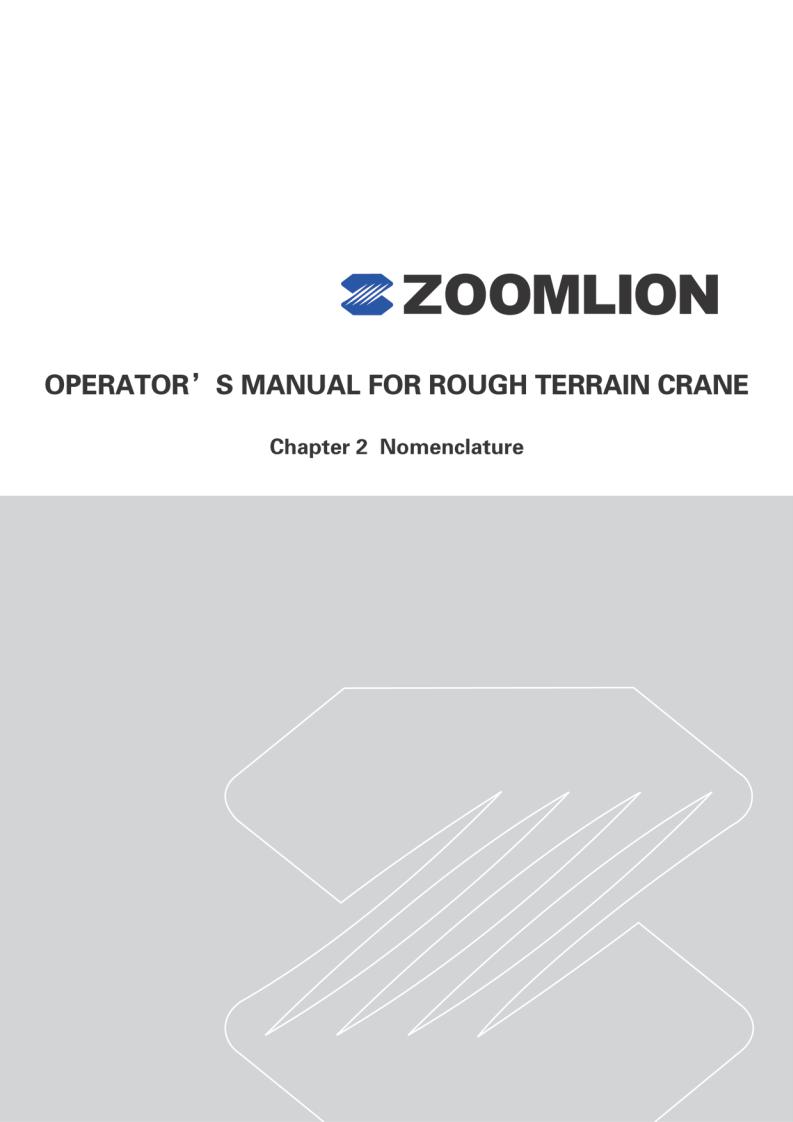
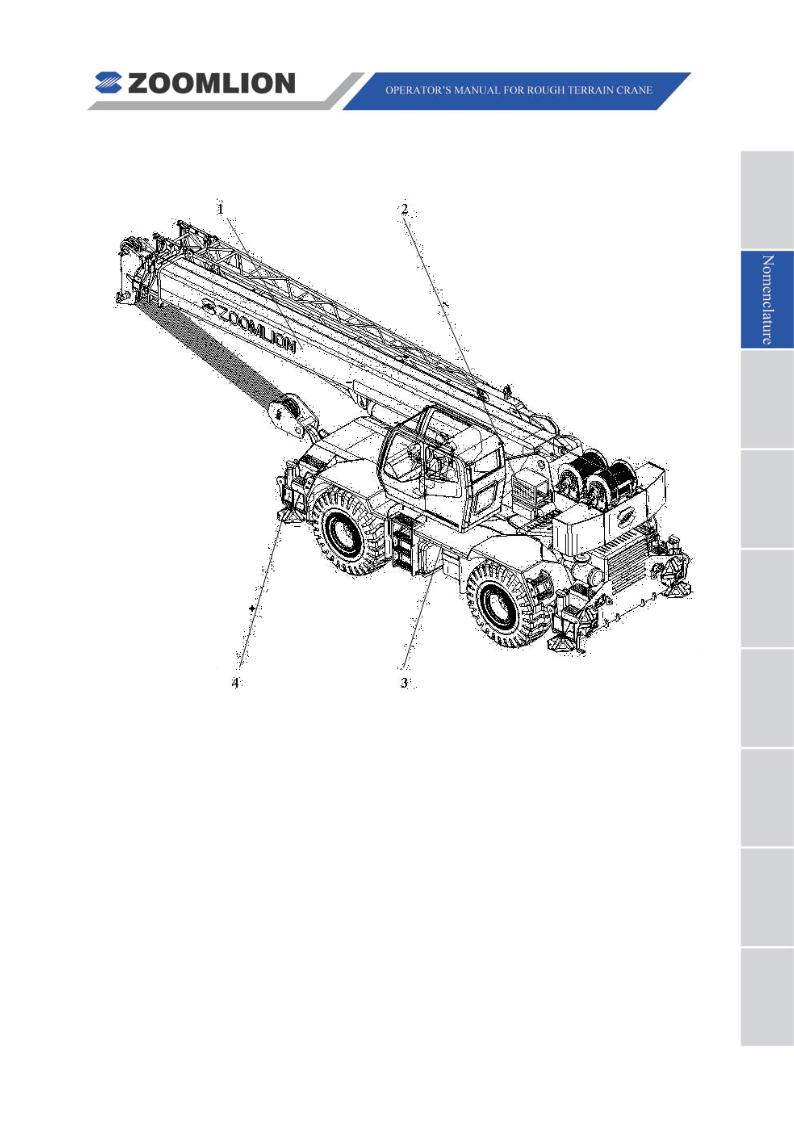
To help you understand the contents of this manual, refer to the figure below. Each numbered term can represent several components of the same main part.
LEGEND
1. BOOM SYSTEM = Main boom assy., jib assy., telescoping mechanism, hook block,
|
auxiliary hook, hoist rope. |
2. SWING SYSTEM = Superstructure, counterweight, main and auxiliary winches, |
|
|
swing bearing, swing reducer, derricking cylinder, cab, air |
|
conditioner and cab heater. |
3. CHASSIS |
= Power system, drive system, steering system, air intake system, |
|
exhaust system, cooling system, fuel supply system, chassis |
|
frame assy. and vehicle body system. |
4. OUTRIGGERS |
= Outrigger beams, outrigger jacks, cylinders and outrigger floats. |
RT60 Rough Terrain Crane |
02 - 1 |

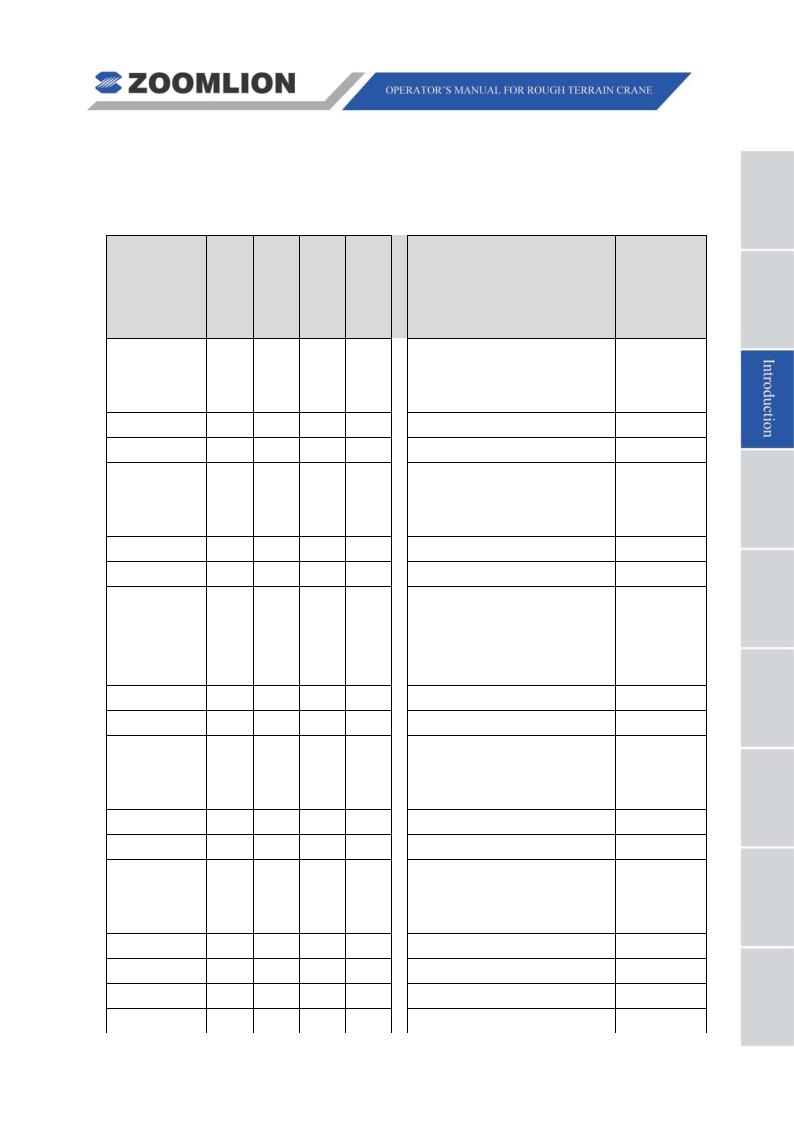
CRANE PERIODIC INSPECTION CHECKLIST
This inspection checklist provides supplementary data to facilitate the correct operation and maintenance of the crane.
Component Inspected |
Interval |
Function |
Adjusting Condition |
Maintenance condition |
Component Inspected |
Inspection Code |
Function |
Adjusting Condition |
Maintenance Condition |
RT60 Rough Terrain Crane |
03 - 1 |
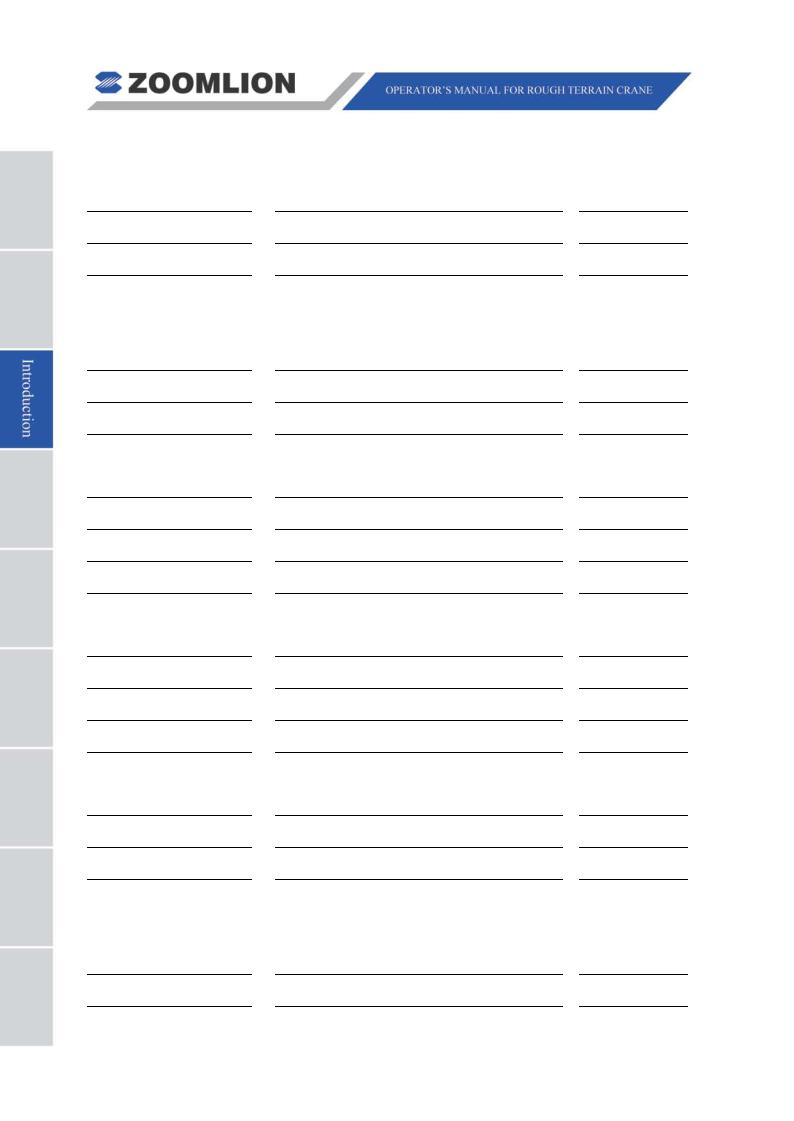
|
MAINTENANCE LOG |
|
Item |
Adjusting Condition |
Date |
03 - 2 |
RT60 Rough Terrain Crane |

About This Manual
General
The data (data, specifications, illustrations) in this manual is for cranes in production at the time of this manuals publication. We reserve the right to make changes to this manual at any time, without obligation.
This manual contains the instructions to move and operate the RT75 Crane in the field. Follow the operation and maintenance procedures to make sure that your machine operates at MAXIMUM EFFICIENCY. Use the CRANE PERIODIC INSPECTION CHECKLIST. Keep a maintenance log to monitor all maintenance work on the machine.
An example of a Maintenance Log and Crane Periodic Inspection Checklist is at the beginning of this section.
Again, we appreciate your selection of our crane. User safety is most important. To complete on-site tasks safely, operators must be responsible. Obey the instructions that follow:
Comply – with Occupational Safety and Health Administration (OSHA), Federal, State, and Local Regulations.
Read, Understand, and Follow – the instructions in this and other manuals and documents that come with the crane.
Use Good, Safe Work Practices – in a common sense way.
Only have trained operators – directed by informed and knowledgeable job-site supervisors.
Do not use this crane – before the portable fire extinguisher, installed in the cab, agrees with local fire protection rules.
Note
OSHA prohibits the alteration or modification of this crane without written manufacturer’s approval. Use only factory approved parts to service or repair the crane.
If you make modifications/additions "which affect the safe operation of the equipment" to the crane before you use it, the crane owner must make sure that the modifications/additions agree with OSHA 1926:1412.
RT60 Rough Terrain Crane |
03 - 3 |

Speak with us if special data is necessary for the maintenance or operation of your RT75 Crane. Send your machine model and a serial number to make sure that you receive the correct data.
If there is anything in this manual that is not clear or which you think is necessary, write to the address that follows:
Rough Terrain Crane R & D Institute Zoomlion Mobile Crane Branch Company Quantang Industrial Park, 2nd Yuanda Road,
Economic and Technological Development Zone, Changsha, Hunan Province, China, 410131
You can also speak to us by telephone at 0086-84671987 (international), 0731-84671987 (domestic).
03 - 4 |
RT60 Rough Terrain Crane |

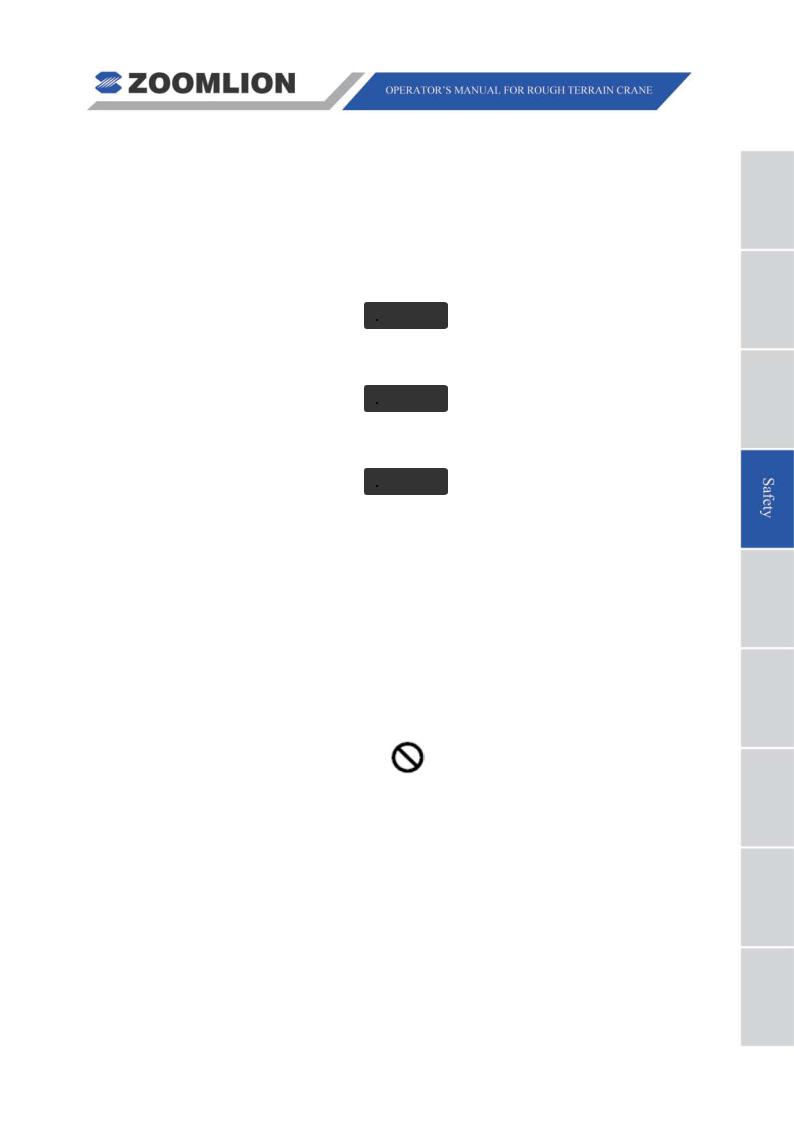
4.1 HAZARD INDICATORS
DANGER, WARNING, CAUTION, ATTENTION, NOTE, and IMPORTANT labels are on signs and decals, and as you read this manual to show important instructions. In this manual, DANGER, WARNING, and CAUTION labels are before the paragraph or item to which they apply. ATTENTION, NOTE, and IMPORTANT follow the paragraph or item they apply to. The markers are as follows:
 Danger
Danger
Refers to a dangerous situation which, if you do not prevent, will cause death or injury.
 Warning
Warning
Refers to a possible dangerous situation which, if you do not prevent, could cause death or injury.
 Caution
Caution
Refers to a possible dangerous situation which, if you do not prevent, may cause light or moderate injury.
Attention
Refers to a situation which, if you do not prevent, may cause property or equipment damage.
Note
Refers to a tip or hint in the operation instructions.
Important
Emphasizes the importance of the data in this manual.
This symbol shows a step or procedure that is not approved and can cause a dangerous situation.
RT60 Rough Terrain Crane |
04 - 1 |

4.2 SAFETY SYMBOL
The safety symbol, used on the Danger, Warning, and Caution labels, tells personnel of possible death, injury, or property damage. Obey all safety data that follows this symbol to prevent dangerous conditions.
 Danger
Danger
 Warning
Warning
 Caution
Caution
4.3 Hazard classification
Hazard classification is a system to show different classes of possible injury levels. A safety symbol and a signal word show how dangerous the level of possible injury can be.
A signal word without a safety symbol refers to property damage, protection devices, or important data. You will find this system used in this manual and on signs on the crane to help find and prevent dangerous situations.
4.4 SAFETY
This section contains the safety rules that you must follow. You must read and understand the Operator’s Manual. It contains the instructions for the specified machine.
All personnel must be safe at the work location.
Attention
A.Moving personnel
Only use a crane to lift personnel when it is the less dangerous mode to move them to areas that are hard to access.
B.Operator’s responsibilities
Read and understand the Operator's Manual.
The operator must always think about the safety of all personnel in the area.
Only personnel who show that they can safely control a RT75 crane can operate the crane.
Comply with the requirements, that apply, as follows:
Occupational Safety and Health Administration (OSHA) standards
American National Standards Institute (ANSI)
China National Standards GB/T3811.
Make sure that all the mechanical functions of the crane can operate.
04 - 2 |
RT60 Rough Terrain Crane |
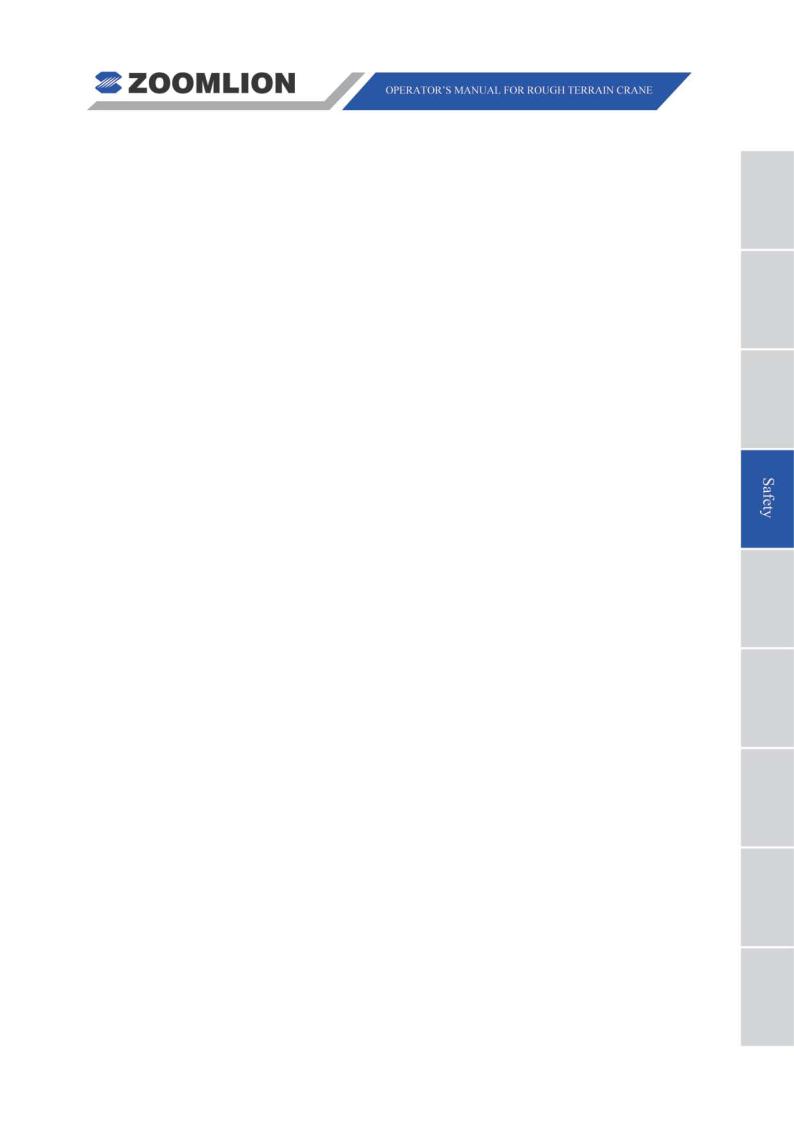
Make sure that the system operating gauges and indicators, and warning signals function.
Keep all the glazed surfaces, instruments, windows, and lights clean.
Remove all oil, grease, mud, ice, and snow from walkway surfaces.
Read and understand all Decals and Warnings.
Keep all tools and other necessary items in the toolbox.
Do not lift a load without a Load Ratings in the cab.
Read and understand the Load Ratings.
Make sure that the load to lift is less than the capacity of the crane.
Be in good physical condition and free from effects of alcohol, drugs and medications. Be sure to not decrease vision, hearing, or reaction time.
Keep personnel, equipment and material that are not necessary for your task at the job-site out of the area.
The operator must know the hand signals.
When the view of the operator is blocked or if the task is in a dangerous area, use signal personnel to give directions.
If a signal person is necessary, the operator must obey only the signals from the approved signal person. You must obey the STOP signal from all personnel in the area.
Keep a fully charged fire extinguisher and first aid kit in the cab at all times. The operator must know how to use the fire extinguisher and how to apply the items in the first aid kit.
Look for the movement of other equipment, trucks, and personnel at the job-site.
Personnel must stay off the crane platform while the crane is in operation.
All personnel must be in a safe area before you move the hook, boom, load, or outriggers.
Stop and start the movement of the load smoothly and move at a speed that keeps the load in your control.
Keep a minimum of three full wraps of wire rope on the drum.
Use the tag lines to keep the load in control.
Keep the load near the ground.
Use the shortest boom possible.
If a load is off the ground or the crane is on, you must stay in the cab.
Always use outriggers as the Load Ratings and Operator’s Manual tells.
RT60 Rough Terrain Crane |
04 - 3 |

C.Signal personnel responsibilities
Use and understand all standard hand signals.
Help the operator to operate safely and satisfactorily. Keep safe all personnel and property.
Understand the work you must do.
Stay where you can see the full operation and where personnel can see you.
D.Responsibilities of all crew members
Correct the conditions and procedures that are not safe.
Obey WARNING signs.
Do your work safely and do not make dangerous conditions.
Know and understand correct procedures for crane erection and rigging.
Tell the operator and the signal person of dangerous conditions (power lines/cables, work surface that is not stable etc.).
E.Management responsibilities
The operator must be competent, in good physical condition and have applicable licenses.
The operator, signal person, and riggers must receive training in correct crane operation.
The operator and the signal person must know all standard hand signals.
Have a supervisor at the job-site to be responsible for safety.
Give crew members the safety instructions and tell them to report conditions that are not safe to the supervisors.
Supply the operator with accurate data on the load that they have to lift.
Make sure that all personnel know applicable OSHA and ANSI B30.5 requirements and the instructions in manuals.
F.Planning the job
Understand the work that you must do.
Think of all possible dangerous conditions/risks at the job-site.
Know the type of personnel that is necessary.
Give the tasks to personnel.
Know the weight of the load that you must lift.
Find the lift-radius, boom angle, and the rated lift limits of the crane.
Tell the signal person how to communicate with the operator.
04 - 4 |
RT60 Rough Terrain Crane |

Use equipment which does the work safely.
Make a decision on how to safely move equipment to the job-site.
Find gas lines, power lines and structures.
Make sure that the work surface can hold the crane and load.
Find out how to rig the load.
If necessary, make the special safety precautions.
Know the weather conditions.
Keep equipment that is not necessary away from the job-site.
Set the crane to use the shortest possible boom and radius.
G.Operator safety check
Safety related items must be in position.
Look at the crane logbook for maintenance and inspection records.
Make sure to complete necessary repairs.
Examine the wire rope for damage (kinks, broken wires etc.).
Make sure that all field modifications are approved.
Do an inspection for air and hydraulic oil leaks.
Examine the control positions before you start the engine.
After you start the engine, examine all the instruments and indicators for the correct values.
Do a test on the controls.
Check brakes.
Lift and hold a load 2 inch (50 mm) off of the work surface to examine the load brakes.
H.Operator aids check
Anti-Two Block devices
Boom angle indicator
Backup alarms
Swing lockout device
Rated capacity indicator (RCI)
3rd wrap indicator.
I.Operation overload prevention
Know the weight of the load.
Decrease radius at the start of the lift to let the load radius increase during lift.
RT60 Rough Terrain Crane |
04 - 5 |

Know the weight of the hook and rigging.
Know the boom length, jib length, and the area where you have to move the load.
Use next lower rated capacity when working at the boom length or radius between the figures on the rated lifting capacity chart.
Do not lift a load until you know if the load is less than the capacity limit of the crane.
Only operate with the recommended counterweights. It is dangerous if you do not use the approved charts to calculate the decrease or increase in counterweight.
Do not lift the load if winds are dangerous. If necessary, lower the boom.
See the Load Ratings for possible restrictions.
Avoid side loading.
Do not let the load or other objects hit the boom.
Release the load slowly, be sure the boom does not tighten against back stops.
Put the boom point directly above the load.
Be sure that the load hangs freely.
J.Operation setup
Be sure the load-bearing surface can hold the weight of the crane and load.
Make crane level, check frequently, and re-level them when necessary.
Assemble barricades to keep personnel out of the load move radius.
K.Power line safety
Find power lines in the area before you start a task. Follow national and local regulations and ANSI B30.5 when you operate around power lines.
Do not remove the material from below power lines if the boom or crane can touch the lines.
Do not let the crane or load touch electrical lines. Do not go near the minimum permitted clearance for operation of a crane near electrical lines.
If you touch the electrical lines, stay on the crane until the boom moves off the lines or until the power line current is off.
Keep all personnel off the crane if it touches power lines. If you must move from the crane, JUMP, DO NOT STEP OFF. Jump with feet together.
Use a signal person when you operate around power lines
L.Slip and fall prevention
Make sure that you stop the crane before you move on and off the equipment. Do not jump.
Do not use the controls and the steering-wheel as hand holds.
04 - 6 |
RT60 Rough Terrain Crane |

Keep the equipment clean and dry.
Replace all broken ladders.
Keep the non-slip surfaces in good condition.
Wear a safety harness when you climb the counterweight and attach the harness in the necessary points. Do not walk on the boom!
M.Travel
Be careful when you move cranes on or off the job-site.
Look for personnel, power lines, low or narrow clearance, bridge or road load limits, steep hills, or rough terrain.
Correctly stow the boom before you move the crane.
Inflate the tires to the specified pressure.
Move slowly and prevent sudden movement.
Wear seat belt correctly when you move the crane.
Make sure that the travel surface can hold the weight of the crane and load.
Always use the park brake when you park the crane.
N.Safety sign maintenance
During the daily inspection, make sure that the decals show and are in good condition. Replace all missing or damaged safety signs. The safety of the operator is always important.
Use a weak soap and water to clean the safety signs. Do not use solvent-based cleaners. Solvents can cause damage to the safety sign material.
The graphics, on the pages that follow, give an example of each safety decal and its location.
RT60 Rough Terrain Crane |
04 - 7 |
